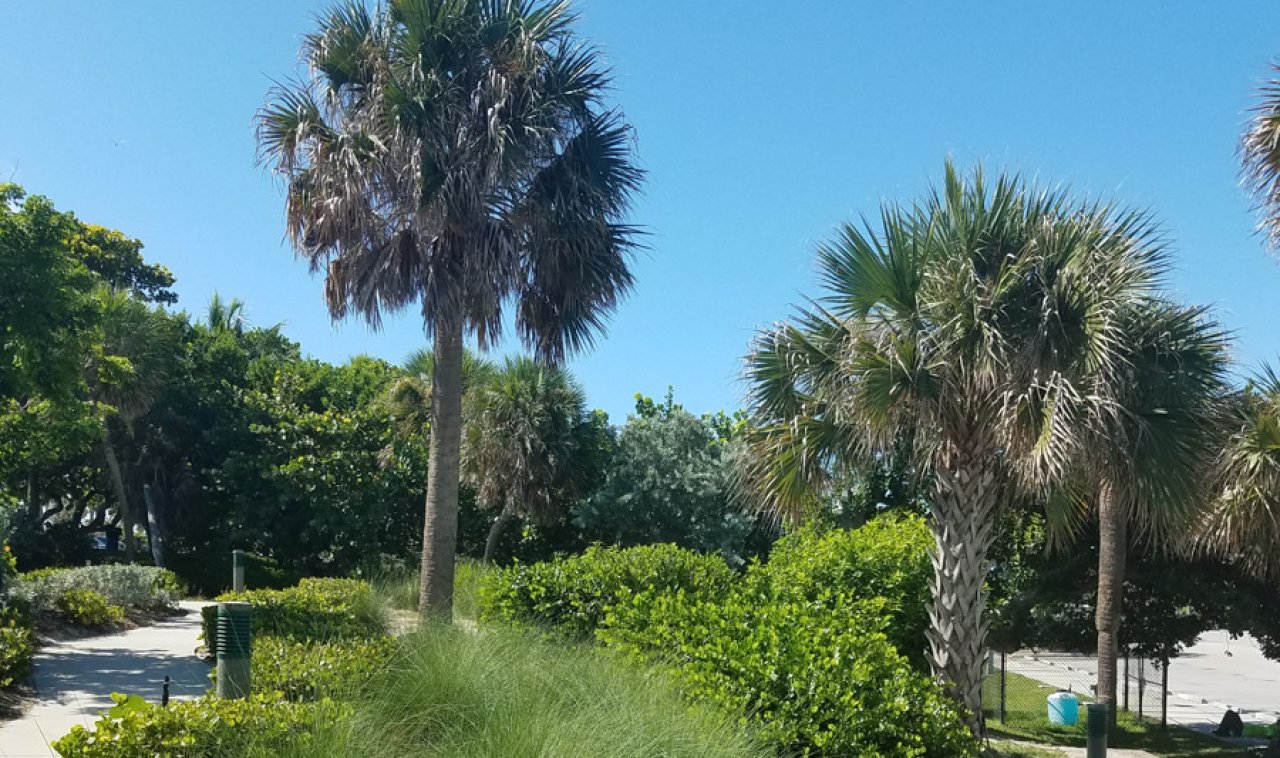
Groundcover Selection and Planting
The planting of groundcover in lieu of rock or turf/grass fulfills many of the Comprehensive Plan objectives and Florida Friendly Landscape Principles that have been codified as part of the City’s landscape code requirements
The planting of groundcover in lieu of rock or turf/grass fulfills many of the Comprehensive Plan objectives and Florida Friendly Landscape Principles that have been codified as part of the City’s landscape code requirements as illustrated below:
The reduction of turf grass and the planting of native and/or drought tolerant groundcovers helps to conserve water.
Meets many of the Florida Friendly Landscaping Principles such as Right Plant-Right Place, water efficiently, attract wildlife and reduce stormwater runoff.
The planting of site-specific native and drought-resistant plant materials helps create larger and more connected plant populations which provides food, shelter and habitat for birds, pollinators and other animals.
Drought tolerant native groundcovers and plants help reduce the cost of landscape maintenance by reducing the amount of irrigation required and the frequency of maintenance.
The planting of groundcovers allows for creative landscape designs.
The City’s Landscape Design Standards also requires the following:
Reduce turf sod areas and utilize less water demanding materials such as low water demand shrubs and living groundcovers in conjunction with organic mulches.
Since a major portion of water demand used for landscape purposes is used to irrigate lawn it is recommended that turf/grass areas outside of gathering or recreational areas be converted to natural plant communities or planted as redeveloped native areas or planted with a mix of native and/or drought tolerant groundcovers.
Landscape Code Requirements
Groundcover is a functional term, which, as the name implies, describes plants whose primary role is to cover open ground. Those with either creeping or clumping growth habits are most often thought of as useful for this purpose. However, other low growing plants are also used. Below are some important definitions in City’s Code of Ordinances that pertain to the planting and maintenance of groundcover.
Ground cover definition: Plant materials in the interest of water conservation are encouraged to be used in lieu of grass in whole or in part. They shall be planted in such a manner as to present a finished appearance and reasonably complete coverage.
Organic mulches. Organic mulches shall be used in combination with living plants as part of a landscape design as provided in this section. However, organic mulches shall not, by themselves, constitute landscaping and shall not be used as a substitute for turf in the front yard of single-family, duplex or triplex residential lots. No more than fifty (50) percent of a front or side street setback or yard may be comprised of mulch independent of living plant materials. All planting areas shall incorporate the use of organic mulch and it shall be applied to a minimum depth of three (3) inches. A layer of organic mulch shall be required in all plant beds and around individual trees in turf grass areas, but pulled away from direct contact with stems and trunks to avoid rotting. The use of cypress mulch is discouraged.
Ground covers. Living ground covers and native grasses used in lieu of turf or sod, in whole or part, shall be planted at such spacing to present a finished appearance and reasonably complete coverage within six (6) months based on the expected mature spread. Ground covers that have an expected mature spread of twenty-four (24) inches or less must be planted twelve (12) inches apart. If the expected mature spread is greater than twenty-four (24) inches the groundcovers must be planted eighteen (18) inches apart. Groundcovers shall not be planted in straight rows; the planting must be staggered to ensure even coverage. All ground cover areas must be kept free from weeds.
Recommended Groundcovers
Please see the groundcover planting guide below that provides recommended planting spacing based on species and plant size. If groundcover plants are established in accordance with the following specifications, then it is anticipated that the groundcover will achieve the code required coverage within 6 months of planting.
Groundcover Planting Section Example
(Source: Urban Tree Foundation, www.urbantree.org, 2023)

Recommended Groundcovers
Native Groundcovers
Common Name/ Scientific name | Spacing | Exposure | Pot Size | Photo |
Beach Sunflower/Helianthus debilis | 24 inches | Full sun | 6 inches |
|
Coontie/Zamia integrifolia | 24 inches | Full sun to Full Shade | 1 gallon |
|
Dwarf Yaupon Holly/Ilex vomitoria ‘Nana | 18 inches | Full sun to partial shade | 3 gallons |
|
Spider Lily/Hymenocallis latifolia | 18 inches | Full sun to partial shade | 1 gallons |
|
Cocoplum-Horizontal/ Chrysobalanus icaco L. | 24 inches | Full sun to partial shade | 3 gallons |
|
Muhlygrass/ Muhlenbergia capillaris | 24 inches | Full sun to partial shade | 3 gallons |
|
Sunshine Mimosa/Mimosa strigillosa | 18 inches | Full Sun to partial shade | 1 gallon |
|
Beach Creeper/Ernodea littoralis | 18 inches | Full Sun to partial shade | 1 gallon |
|
Fakahatchee Grass/Tripsacum dactyloides | 18 inches | Full Sun to partial shade | 3 gallon |
|
Beach Verbena/Glandularia maritima | 12 inches | Full sun | 1 gallon |
|
Railroad Vine/Ipomoea pes-carrae | 18 inches | Full sun | 1 gallon |
|
Non-Native Groundcover
Common Name | Spacing | Exposure | Pot Size | Photo |
Asistic Jasmine/ Trachelospermum asiaticum | 18 inches | Full sun to Part Shade | 6 inches |
|
Perennial Peanut/Arachis glabrata | 18 inches | Full sun | 6 inches |
|
Blanket Flower/Gaillardia | 12 inches | Full Sun | 1 gallon |
|
Shore Juniper/Juniperus conferta | 24 inches | Full Sun | 1 gallon |
|
Cast iron plant/ Aspidistra elatior | 12 inches | Partial sun to heavy shade | 1 gallon |
|















